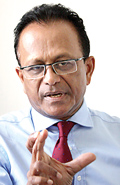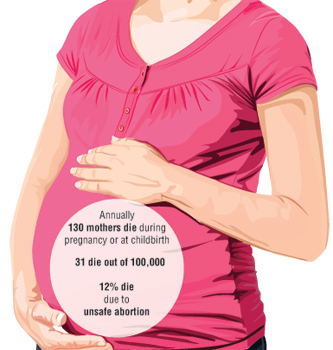When a mother dies 3 generations suffer
It is a heart-rending photograph of a humble ‘family’ taken before their half-built home, adjacent to their cadjan-thatched mud hut. Although there are three generations in this photograph, one crucial member is missing – the mother. Prevention of maternity deaths has become the quest of the Sri Lanka College of Obstetricians and Gynaecologists (SLCOG), with Prof. Hemantha Senanayake at the helm.

Prof. Hemantha Senanayake
To achieve ‘zero maternal deaths’, Prof. Senanayake and his team are bent on setting up a state-of-the-art Training and Simulation Centre at the premises of the SLCOG down Model Farm Road, Colombo 8. Underscoring the fact that Sri Lanka’s maternal mortality (death) rates are “good” when compared to other Third World countries, Prof. Senanayake who is also the Head of the Department of Obstetrics and Gynaecology, Colombo Medical Faculty said that every single maternal death is thoroughly investigated.
“This is unique,” he says, pointing out that this process helps learn many lessons. Prof. Senanayake who has been part of these maternal death reviews stresses that even though this figure (see graphic) is low, at least half these deaths are preventable.
When asked how the idea for a Training and Simulation Centre came about, he said that the SLCOG has been conducting Safe Motherhood Programmes for a long time. Under these programmes, teams go to different areas and train midwives, nurses and doctors providing care for pregnant women.
Coming across a need to raise funds for such educational activities, the SLCOG felt it would be better to build on this foundation by setting up a permanent centre. The SLCOG’s vision is to provide high-quality, real-life training at this centre, the Sunday Times learns.
“It will be well-equipped and have electrically-controlled mannequins whose pulse could be felt, ECG recorded, a cuff put on and blood pressure taken as well as to whom drugs and drips can be given,” says Prof. Senanayake, looking into the future.
Death reviews have brought to the fore the recurrent fact that mothers die not for want of knowledge on the part of the people attending on them but due to the lack of well- coordinated management of an emergency, it is understood.

“Fast action is essential in such an emergency,” says Prof. Senanayake, adding that there should be quick communication between personnel. “It must be a drilled-in automatic response to an emergency. Then, at least half of these deaths can be prevented.”
When a mother dies three generations are affected, reiterates Prof. Senanayake, elaborating the impact on the grandparents, the spouse and the children. “You need to save the mother, mainly for the children left behind. In many cases, the children are taken for so-called adoption but not to be looked after but to do menial jobs. Siblings are torn asunder, never to meet again.”
The top-killers of mothers are pregnancy-related haemorrhages, unsafe abortions and heart disease. While haemorrhage-linked deaths are decreasing, unsafe abortions remain a major concern, according to this Consultant Obstetrician and Gynaecologist.
Dealing with heart disease, he says whereas earlier the issue was structural abnormalities (which are now detected and treated), the trend is changing with the emergence of peripartum cardiomyopathy. When afflicted with this condition, the mother’s heart muscle fails late in pregnancy. This can continue up to six months after the birth of her baby.
Unsafe abortions are a severe worry for the SLCOG because 12% of all maternal deaths annually are due to this. Concerned about socially-stigmatized pregnancies — which include young unmarried girls, married women who get pregnant while their husbands are away or those who conceive a baby while working abroad – he cites the example of a widow.
She had three children but had become pregnant after her husband’s death. Concealing the pregnancy, she had the baby in her home alone and then buried the baby in the garden. It was when those around her noticed severe bleeding that she was taken to hospital — but it was too late, says Prof. Senanayake with sadness, stressing the importance of making them aware of contraception, to prevent unnecessary deaths.
“There is a high incidence of suicide among these women, while they also face gender-based violence at the hands of their partners. Some of these suicides may not seem what they are but deaths at the hands of their partners,” he says, adding, “This is what we want to change.”
And this is in keeping with the objectives of the Association of Obstetrics & Gynaecology which was formed 60 years ago in 1953 and later evolved into the SLCOG which are clear and simple.
Pointing out that the association is not a trade union nor does it exist for the main purpose of fighting for the rights and privileges of its members, its role is crystal clear: “The only fight that figures in our aims is that against maternal and infant mortality.”
‘Fashion Sri Lanka – Spring/Summer 2014’ takes up the cause
It will not only be models who will take to the ramp but 16 cricketers as well, when well-known names in the arena of couture present ‘Fashion Sri Lanka – Spring/Summer 2014’ on November 24 at the Galadari Hotel in Colombo. They have taken up the cause of the mothers of Sri Lanka and are hoping to raise funds for the establishment of the Training and Simulation Centre estimated to cost around Rs. 30 million.
JAT Holdings has already come in as the principal sponsor and hopes to continue its support as part of its corporate social responsibility project. The SLCOG is requesting all those who wish to help to buy a ticket for ‘Fashion Sri Lanka’ and save a mother from death.
Tickets for ‘Fashion Sri Lanka’ produced and choreographed by Lou Ching Wong are available at JAT Holdings Nawala, Herman Miller Showrooms, Ramani Fernando Salons, SLCOG and several other institutions. Generous donors may also send in their contributions in the form of a cheque drawn in favour of ‘Save the Mothers Fund’, Account No. 75303475 at the Bank of Ceylon, Regent Street Branch, Colombo 10. The cheques could be posted to the Sri Lanka College of Obstetricians & Gynaecologists, 112, Model Farm Road, Colombo 8, Sri Lanka.
For more information please access http://www.slcog.lk or contact Phone: 011-2689036 or email: slcogoffice@gmail.com



